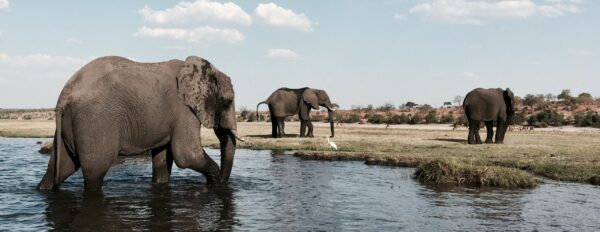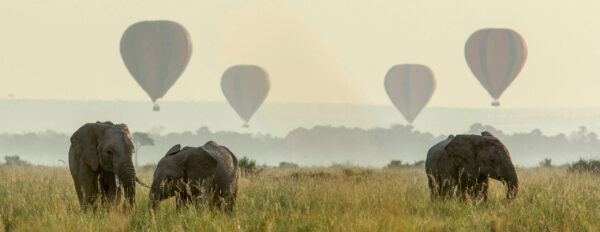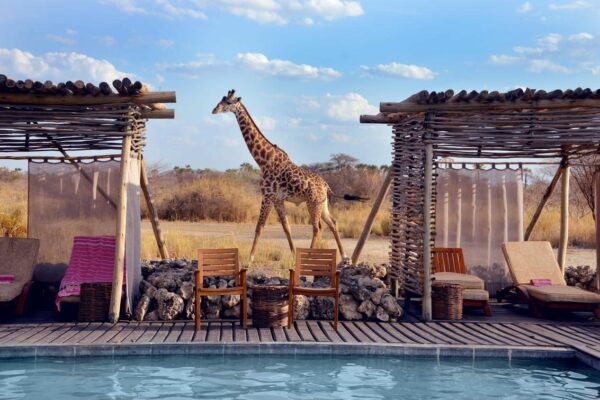From tracking streams of migrating wildebeest in the Serengeti to stalking the resident wildlife trapped in the Ngorongoro Crater and fly camping in Nyerere National Park in the remote south, Tanzania’s safari experiences are wonderfully diverse. Marry one with an extension to Zanzibar, hiking in the Rift Valley, or an ascent of Kilimanjaro, and before you know it, two weeks in Tanzania are quickly sketched into a dream itinerary. Just as diverse as the scenery, are the choices of camps, means of transportation, activities, and seasonality—factors that all directly impact budget.
As far as Tanzania safari prices go, it’s generally a little costlier than its East African neighbor, Kenya, but less expensive than Botswana, which sits at the top of the safari market.
In this article, we will outline how much a Tanzania safari costs—and why.
The average cost of a luxury safari in Tanzania
Extraordinary Journeys safari specialists recommend budgeting $1,000 per person, per night as a starting point for undertaking a luxury safari in Tanzania.
Even within the luxury category, the average Tanzania safari price can vary widely depending on many factors. When are you traveling? Does it coincide with the Great Migration or school holidays? Do you prefer the exclusivity of a three-tent mobile camp or the amenities of a 15-suite lodge? Will you be flying between camps or driving? How many days do you intend to travel for?
During peak migration season staying at a premium, five-star camp in a private game reserve, this figure easily creeps toward $2,000—and higher.
If you plan to include non-safari days—like climbing Kilimanjaro or a beach getaway to Zanzibar—the $1,000 daily average might fall by half. (Ultimately, any day that you’re not actively on safari will be less costly.)
Tanzania is also a wonderful place to enjoy a luxury walking safari, which might cost around $800 per person per day if you’re exclusively fly camping.
Sample luxury Tanzania safari itineraries for all budgets
Tanzania-the Ultimate Luxury Safari – $20,000–$26,000 per person; 10 days
Classic Migration Safari, by Private Vehicle – $10,000–$12,500 per person; 10 days
Tanzania’s Remote and Wild South – $7,900–$9,800 per person; 9 days
Explore Northern Tanzania – $7,300–$9,900 per person; 9 days
*All prices listed for 2023
What’s included in the cost of a luxury Tanzania safari?
The price of a luxury Tanzania safari is pretty well all-inclusive and will cover accommodation, all domestic transportation, expert guides and trackers, game drives in shared or private vehicles, gourmet meals, bar, picnics and sundowners in scenic spots, laundry, and park fees. Activities like guided bush walks near camp and community visits are commonly included.
Spa treatments, hot air balloon safaris, exclusive upgrades (like private vehicles), star beds, fly camping, helicopter transfers, and scenic flights are optional add-ons.
Your trip will also include pre-departure preparation and in-destination support from Extraordinary Journeys. We have reliable boots on the ground and a 24/7 concierge just a phone call or WhatsApp message away.
You’ll need to budget for international flights, visas, gratuities, travel insurance, and incidentals.
Factors influencing Tanzania safari prices
Tanzania safari costs depend on a variety of moving factors, including the month of travel, accommodation style, mode of transport, and how far in advance you book your trip.
You can save yourself hours of research by engaging a safari specialist from the get-go. Working with an Extraordinary Journeys expert who can custom design your safari will ensure you have the trip of your dreams, within budget.
Time of year
- Peak season: Generally, traveling between June and October is the busiest and most costly, with July and August representing the peak. The festive season (December 20 through January 5) also sees rates jump—and the prices of international flights rise, too.
- Migration season: The Great Migration cycles annually between Kenya’s Maasai Mara National Reserve and Tanzania’s Serengeti. It’s a completely organic phenomenon and there are no hard and fast rules, but there are some trends in terms of animal movements and safari costs. Rates at camps in the northern Serengeti (both permanent and mobile) will peak in summer, as will mobile camps when located in the southern Serengeti. Those southern mobile camps bump up again at the top of the year as animals begin to arrive at their grazing and calving grounds. An Extraordinary Journeys safari specialist can help make sense of it all and save you hours of research.
- Secret season: Also known as green season, secret season starts in mid-January when families have settled back into the school calendar, and typically runs through to May. A second secret season takes place in mid-October and runs to early December. Rates may soften (or, in some cases, not), but you’ll certainly get more safari for your buck. With fewer crowds and far quieter camps, you might receive complimentary upgrades—like a private game drive vehicle—but at the very least, you’ll enjoy a more exclusive experience. (In addition to a whole host of other amazing reasons to travel during secret season.)
Mode of safari
Like most safari destinations, bush flights are a scenic, convenient, and practical way to get around. And in many cases, they’re the only comfortable way to travel the very long (and bumpy) driving distances through Tanzania’s remote south.
However, the country is one of the few places where Extraordinary Journeys safari specialists feel a driving safari can be well enjoyed—a mode of transportation that can be less costly than flying between camps. We recommend a driving safari when touring Tanzania’s northern circuit, where destinations are about three hours apart. Private vehicles and drivers are charged as a flat rate, so it’s an affordable alternative to flying for families and small groups.
When choosing this option, it’s important to keep in mind that the vehicle will have a hard top because you’re traveling on highways. This same vehicle will be used when you go on game drives which means you won’t be using your camp’s fleet of open-sided or sometimes photography-specialized vehicles.
Airfare and number of flights
The more frequently you change locations or properties, the more budget you’ll need to allocate to bush flights. Typically we recommend no fewer than three nights at a camp, which yields two full days on safari, and you’ll feel less rushed. In some cases, long-stay promotions are offered to guests who stay three or more nights, or to travelers who choose to stay at lodges within the same portfolio.
Lodging type
- Safari Lodges: Lodges offer the most comprehensive amenities of all safari accommodation styles. With handsomely appointed suites, fitness centers, spas, and swimming pools, lodges offer luxury in the middle of the African bush. You’re surrounded by nature, but not in nature.
- Tented safari camps: Safari camps range from basic (we don’t offer these) to barefoot luxe to pure luxury under canvas. While they may not have the hard walls and roof of a lodge, tented camps don’t mean foregoing creature comforts. From claw-foot tubs with brass fittings to star beds and laundry service, you’ll be well taken care of. You may need to be escorted to your tent after dark, but your wilderness experience will be unfettered and unfenced.
- Mobile camps: These tented camps are unique due to, well, their mobility. A few times each year, they relocate depending on the Great Migration “traffic” trends. You won’t have a pool or decking, but you’ll waste no time each morning as you set out on a game drive. In some cases, wildlife viewing might happen from the window of your tent. In terms of amenities, you’ll be using a bucket shower (envision an “old school safari”), but an attentive staff still serves gourmet bush meals and makes lovely gestures like tucking a hot water bottle into your bed sheets.
The ideal safari booking window
Book early. You’ve heard this before, but why is it? And how early is “early?”
To answer the “why,” it’s all about supply and demand. The camps we sell typically have just four to 10 suites. The later you book, the fewer options we can consider as travel designers. It may mean paying a higher rate than you’d hoped, to get what you want, or having to make a compromise. Destinations like the Serengeti and Ngorongoro Crater are in high demand, and we can not conjure vacancy, so booking well in advance is a safe bet—even if it feels “early.”
How early should you book? We recommend planning 12-18 months in advance. This is especially the case if you’re planning to travel for migration or festive season, if you have specific camps of choice, or if you plan to bring the whole family (you’ll require more specific room configurations.)
Safari circuit
- The northern circuit: The northern circuit contains Mount Kililmanjaro, Tarangire National Park, the Ngorongoro Crater, and Serengeti National Park. It’s popular—for good reason—and though it can be crowded at times, it sets the stage for a truly unforgettable trip.
- The southern circuit: Certainly, the road less traveled, the southern circuit includes Ruaha National Park and Nyerere Game Reserve. It is remote, wild, and the game viewing can be less predictable and more spread out, but it is full of surprises. Tanzania’s dreamy southern landscapes are completely different than what you’ll find in the north. Instead of shady acacia and fig trees, you’ll find stout baobabs and palm trees.
- Western Tanzania: Katavi National Park is one of the most untouched, remote, and least visited regions of East Africa, and in Mahale Mountains National Park, you can sail a dhow on Lake Tanganyika and trek for chimpanzees.
Gratuities
While never demanded, tipping for excellent service and guiding is customary in the safari world. At small camps and lodges, you aren’t an anonymous hotel guest; you’ll get to know your hosts, guides, trackers, staff, and bartender on a first-name basis. Their knowledge, service, and personal stories will be a memorable part of your journey. The Extraordinary Journeys pre-departure team will supply you with a tipping chart, but we recommend $30 to $50 per person, per day.
Visas
U.S. citizens require a visa to enter Tanzania. The cost is $100, and it can be obtained in advance as an e-visa in advance or upon arrival.
Are safaris worth it?
We feel Tanzanian safaris offer fantastic value, especially when compared to the cost of a luxury trip in Europe or North America.
It’s also worth taking the value of sustainable travel into account. Many of our camps and lodges are deeply engaged in conservation efforts—adding environmental and social-economic clout to every dollar you spend there. They are contributing to projects that protect migration corridors, foster biodiversity, support anti-poaching units, create local employment, and community uplift—efforts that are definitely worth supporting with your wallet.
Keep reading

How Much Does a Botswana Safari Cost?
Snug in southern Africa, Botswana is not the most famous, nor the most frequented safari…

How Much Does a Kenya Safari Cost?
Awe-inspiring wildlife moments, snow capped mountains rising high above the savanna and…

What does a safari cost?
How much does it cost to go on safari? The variety of options are as diverse as the people…
Plan your Trip
Ready to start planning your own incredible adventure? We make the process stress-free and enjoyable.
